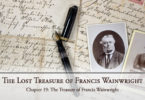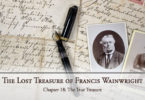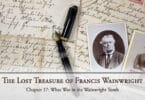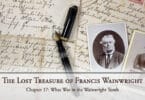Just to be sure they weren’t remembering things wrong, and that they hadn’t missed anything the numerous other times they’d been there, the cousins made the twenty-minute drive to Ipswich to check out the Wainwright tomb at the ancient cemetery there. Just as they all suspected, it was exactly as they remembered it. Francis himself had what was once a large and stately stone sarcophagus on strong stone pillars, but the sides had long ago fallen away and the contents disappeared into the mists of time. All that was left was an inscription with his name, birth and death dates, and a Bible verse on the top slab.
There was also a larger Wainwright tomb built into the side of one of the multi-level cemetery’s many hills. It was one of several walk-in tombs at the cemetery, all dating to before the American Revolution. Each one was set into the side of a small hill, kind of like a Hobbit hole, with the name of the family carved on a large metal or stone slab above a huge metal door, either of iron or copper and usually rusted or discolored with the centuries.
There were locks and knobs on these tombs, but in their many visits here, the cousins had never seen anyone entering them. They all suspected most, if not all, of these tombs, hadn’t been entered since shortly after they were erected. The keys to the various locks were either lost long ago, or in the possession of the descendants of the people who built these tombs, and those descendants likely had no idea what the keys were used for in the first place.
Like all the other walk-in tombs at the ancient cemetery, the Wainwright one was undecorated, except for the name plate. There was no sign of a statue, and since the Wainwright name plate was a stone one, it couldn’t have been made by Samuel Pope.
“Do you think maybe the statue used to be here and was damaged, vandalized, or stolen at some point in the past three centuries?” Grace asked.
“It’s certainly possible,” Adam said thoughtfully, tapping his finger to his lower lip. “But, I don’t even see a pedestal or any kind of foundation where such a statue would be. Do any of you?”
The assembled chorus of mumbled “no’s” answered that question.
“There isn’t a lot of upkeep here, though,” James pointed out. “The cemetery is owned by the city, but they don’t do much more than weed by hand out here, at least not in the ancient part, because there is too much risk of damaging the stones. They are all historical artifacts now, so this lower level where the oldest stones and tombs are is like a museum. That’s why there are always so many leaves on the ground. Maybe a pedestal is actually here, and under the leaves, or even slightly under the ground. The ground is pretty soft and mossy. Anyone up for a little clearing away and digging?”
With the five of them working together, it didn’t take very long to clear the leaves, grass, moss, and top two inches of soil from around the front of the Wainwright tomb. After about half an hour, it was done, and they could all clearly see there was no kind of pedestal hidden underneath any of it.
“You don’t think it could be inside the tomb, do you?” Emily asked a hint of hesitation in her voice. Not only was she not too keen on going inside one of these structures, but she also wasn’t even sure if it was allowed by the city, even for those families who still had keys. These were old, fragile structures, after all.
“It might be,” Christine said as if a light bulb had just come on over her head. Emily hadn’t really thought the statue would be in there, and she didn’t like hearing Christine agree that it might be a possibility.
“Why would Francis put something inside the tomb that he wanted the world to see and admire?” James asked. “Especially something he paid such a large chunk of his fortune to have built?”
Grace smiled, an idea hitting her. “It might have originally been on the outside of the tomb,” she said, enthusiasm creeping into her voice. “That is certainly the most logical place for it. It was in a time when Puritans would certainly have frowned on such ostentatiousness, but it wouldn’t have been illegal by town or church standards for Francis to have it built and placed here. His fellow church congregants probably objected more to him hiring a Quaker to build it for him than to the actual statue and name plate. You know, a lot of the stones in this cemetery, and tons of other ones in Essex County got damaged by musket fire during the Revolution. Maybe the Wainwright family moved those precious, expensive items inside the tomb during the war to protect them, and then forgot they were there over the ensuing generations.”
“But, how would we know?” Adam asked. “And, can we even get in there to look?”
“We can find out about the history of this cemetery at the town hall,” Christine let them all know. “And possible some more at the town library. They have an archive of a sort in the basement there. The records might tell us of any changes, such as a statue of Philippa being there, and then being moved or disappearing. And, since Francis is the only member of the ancient Wainwright family to get their own individual stone that we know of for sure, it makes sense that Philippa is probably inside this tomb with other early generations of Wainwrights.”
“And, getting inside it?” James asked.
Christine smiled. “We will have to ask about that at the town hall, as well. There’s got to be a way for the city to let you in if you’re family. Wouldn’t you think?”
Next: Chapter 15 — What Was Inside the Wainwright Family Tomb?





